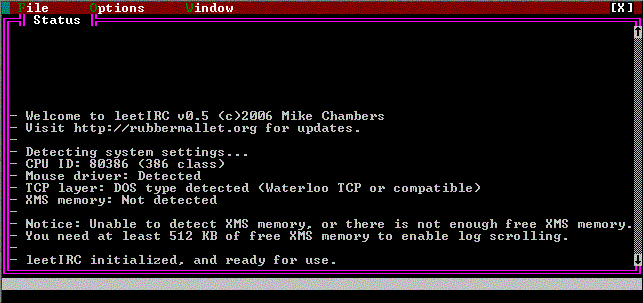Mike Chambers
Veteran Member
- Joined
- Sep 2, 2006
- Messages
- 2,621
i decided to completely rewrite the IRC client for DOS i've been working on from scratch, so that i can optimize it's performance as much as possible so it is not unbearable to use even on an original 8088 PC.
i am going to use interrupt calls for screen writes rather than the PRINT command. PRINT is definately fast enough for 386+ machines, but if it's older it can be so slow that you can literally watch it draw the characters.
i'm also going to add mouse support for the drop down menus and option screens. i am also going to have it use XMS memory for backbuffer scrolling since quickbasic on it's own is very memory-limited... 64 KB i believe? something like that...
i know most original PC's don't have any XMS memory, so in that case i will allow it to use a virtual memory file in case you still want to be able to scroll. you will also be able to disable scrolling if you want, because i know 8088 + constant disk reads and writes on an old MFM drive or floppy can be quite.... frustrating performance wise.
i should have it completed enough to release a beta version within a few days, or maybe by next weekend. i hope some of you could use a decent IRC client for DOS, because i know all the ones out there now are pretty much complete crap.
i also plan to add mirc color/bold support, and DCC file transfers. i'll update you all soon about this program.
don't ever let anybody tell you quickbasic is dead.
i am going to use interrupt calls for screen writes rather than the PRINT command. PRINT is definately fast enough for 386+ machines, but if it's older it can be so slow that you can literally watch it draw the characters.
i'm also going to add mouse support for the drop down menus and option screens. i am also going to have it use XMS memory for backbuffer scrolling since quickbasic on it's own is very memory-limited... 64 KB i believe? something like that...
i know most original PC's don't have any XMS memory, so in that case i will allow it to use a virtual memory file in case you still want to be able to scroll. you will also be able to disable scrolling if you want, because i know 8088 + constant disk reads and writes on an old MFM drive or floppy can be quite.... frustrating performance wise.
i should have it completed enough to release a beta version within a few days, or maybe by next weekend. i hope some of you could use a decent IRC client for DOS, because i know all the ones out there now are pretty much complete crap.
i also plan to add mirc color/bold support, and DCC file transfers. i'll update you all soon about this program.
don't ever let anybody tell you quickbasic is dead.

